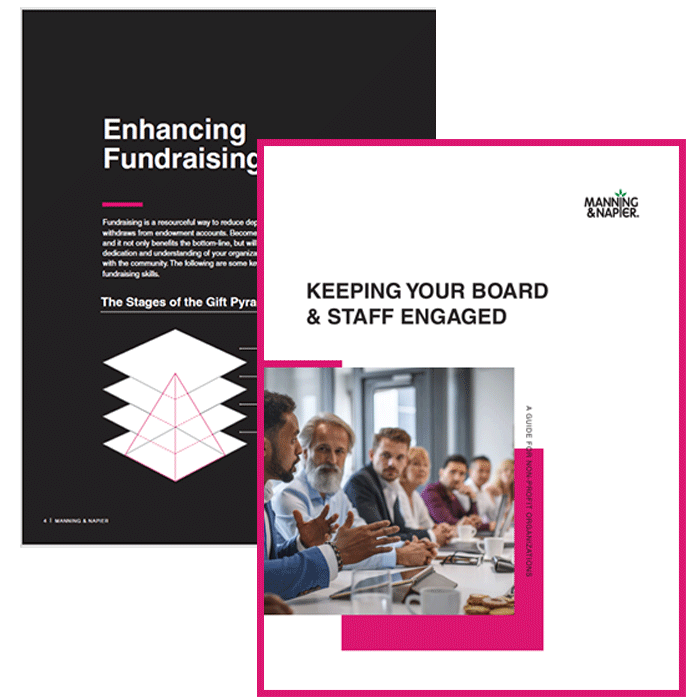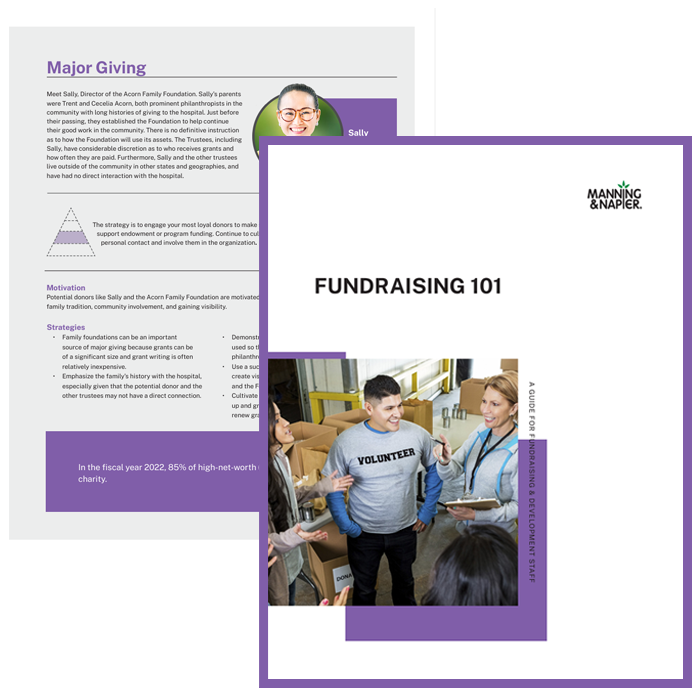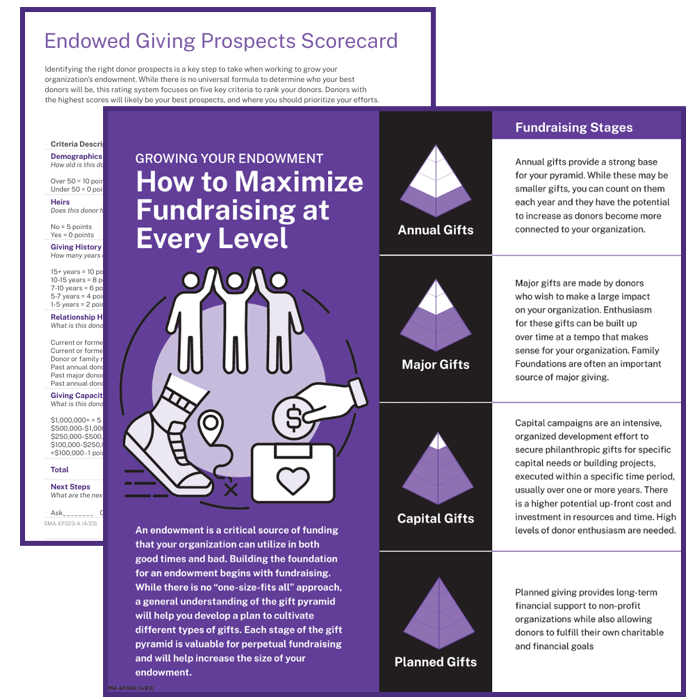The world of philanthropy is evolving, and so are the ways people give. Planned giving offers non-profits more than just financial support – a strategic and intentional program creates lasting partnerships that align donor aspirations with organizational goals.
From cross-training to cultivating younger givers, we’re sharing three ideas that are shaping a new era of giving, one that leaves a lasting impact for decades to come.
Place an Emphasis on Staff Development and Collaboration
There is certainly value in having specialized planned giving fundraising professionals leading your organization’s efforts. These gift officers, as they are often referred to, are responsible for:
- Developing strategies for cultivating and asking planned giving prospects
- Engaging a subset of specific donors, often meeting with them on a regular basis
- Being pseudo experts on estate and financial planning topics and conversant in common planned giving techniques such as bequests, trusts, retirement plans, and appreciated assets
To better integrate planned giving across fundraising functions, organizations have found success in cross-training staff and leadership to be familiar with these same planned giving topics. This way, everyone is better able to:
- Identify and refer prospects to gift officers
- Help to introduce the concept of planned gifts at all donor levels
- Improve collaboration across teams so that donor interaction becomes more seamless.
Non-profit leaders and board members who have a good understanding of these topics are also more likely to support and promote them, and ultimately support planned giving efforts.
Training should also include the development of a unified case statement. What does a planned gift specifically seek to solve, and why should donors support it? If everyone can buy into the same case for support and repeat that message consistently, this will lead to more consistent messaging for all donors.

Guide to Board & Staff Education
Get tips on how to enhance fundraising skills, develop spending rules and policies, set objectives and guidelines for your organization’s portfolio, be fluent in fiduciary responsibility, and understand how market context can help make informed decisions.
DownloadHave an “Investment” Mindset
Planned giving has long been a powerful tool for building endowments and securing an organization’s long-term financial stability. However, it can be years before a gift is realized. Under the old mindset of annual budget cycles focused on immediate revenue, this might be hard to justify. Under a new “investment” mindset, however, this narrative is gradually changing.
An investment mindset means an organization is willing to spend money today on something that will pay off over the long-term. Rather than seeing planned giving as an add-on, organizations are recognizing it as a critical component of their overall fundraising strategy. Having a planned giving program enhances other fundraising efforts – annual fund giving, major giving, and capital campaigns – by strengthening the case for support. A robust planned giving program is how your organization demonstrates that it is committed to the long haul. And it’s been shown that donors who commit to deferred gifts such as bequests tend to also give more throughout their lifetime via annual giving.
Therefore, the return on your planned giving investment not only includes the potential for a large estate gift, but it also includes higher overall engagement, higher levels of affinity, and increased trust during that donor’s lifetime – all of which benefit other types of giving.
Comparing Financial Mindsets |
||
|---|---|---|
Aspect |
Old: |
New: |
Time Horizon |
Short-term; focused on immediate revenue needs |
Long-term; willing to invest now for future payoff |
Planned Giving View |
Seen as an optional add-on; hard to justify within an annual budget |
Recognized as a critical component of overall fundraising strategy |
Impact on Other Fundraising |
Minimal impact; largely separate from annual fund, major gifts, or capital campaigns |
Enhances other fundraising efforts by strengthening the case for support |
Organizational Message |
Focus on current financial needs |
Demonstrates commitment to long-term financial stability |
Donor Behavior |
Limited engagement with deferred gifts |
Donors who commit to deferred gifts often give more during their lifetime via annual giving |
Return on Investment |
Only immediate revenue counted |
Includes potential for large estate gifts, higher lifetime engagement, greater donor affinity, and increased trust |
Strategic Value |
Tactical, reactive approach |
Strategic, proactive approach building financial health |
Identify and Cultivate Younger Donors
To maximize their “investment” in planned giving, organizations are often identifying and cultivating planned giving prospects at a younger age, including those still in the process of accumulating assets (i.e., working age). These donors might not be ready to make a gift commitment, but organizations are finding that the effort in identifying and cultivating them early is worth it.
Giving USA’s latest State of Giving Report shows that younger generations are, and continue to be, engaged with causes important to them.
Annual Giving by Generation |
|||||
|---|---|---|---|---|---|
Generation |
2015 |
2021 |
2024 |
$ Inc/Dec |
% Inc/Dec |
Gen Z |
N/A |
$747 |
$867 |
$120 |
+16% |
Millennials |
$942 |
$1,323 |
$1,616 |
$293 |
+22% |
Gen X |
$1,265 |
$1,220 |
$1,371 |
$151 |
+12% |
Boomers |
$2,921 |
$2,568 |
$3,256 |
$688 |
+27% |
Note: For 2024, the researchers removed several outliers among Millennial and Boomers donors from the dataset to avoid inflating the average for most donors.
Online Giving by Generation |
||||
|---|---|---|---|---|
Year |
Gen Z |
Millenials |
Gen X |
Boomers |
2016 |
N/A |
70% |
61% |
57% |
2022 |
76% |
81% |
69% |
61% |
2024 |
79% |
82% |
69% |
58% |
Source: Giving USA Special Report: Giving by Generation (2024).
To be truly sustainable, a planned giving program should have a robust pipeline of prospects that maximize the aspirational nature of giving. Younger prospects may place greater value on cultivation efforts such as education around giving techniques, events that foster affinity, and transparency into the organization’s strategic future. Cultivation should introduce prospects to planned giving concepts but not ask for a gift right away. Through repetition, listening to donor needs, and careful tracking over time, younger donors will be more engaged and feel more comfortable with planned giving as a concept for when the time is right for them.

Guide to Fundraising
Learn how to maximize fundraising at every level, cultivate donors and increase engagement, and get tips to enhance your development and fundraising programs overall.
DownloadIt’s a marathon, not a sprint
Planned giving takes a patient, long-term approach. Creating a planned giving program to complement your fundraising efforts, will help your organization be top of mind for donors when major life events occur. And this increased engagement and affinity will only further strengthen the likelihood that they support your organization through annual giving.

Your roadmap to growing your endowment
If you’re looking for ways to effectively grow your organization’s endowment, our toolkit can help you get there! Featuring multiple donor outreach templates, an endowed giving prospect scorecard, infographics, and more, this toolkit is filled with actionable resources to help enhance your fundraising.
DownloadThe information in this paper is not intended as legal or tax advice. Consult with an attorney or a tax or financial advisor regarding your specific legal, tax, estate planning, or financial situation.



